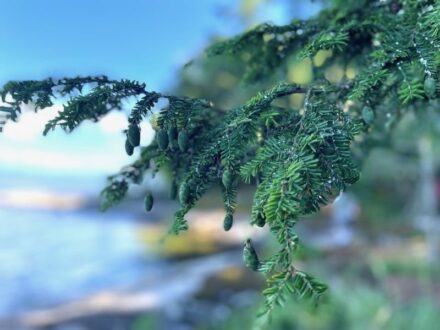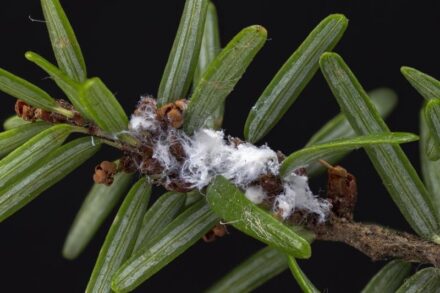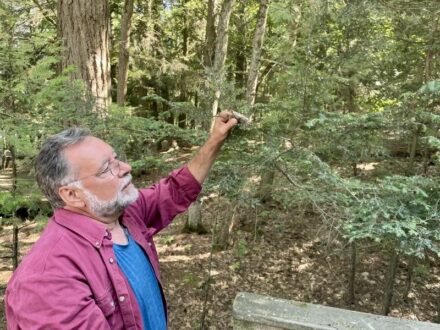DEC and Partners Announce Hemlock Woolly Adelgid Confirmed on the Western Shore of Lake Champlain and Near the North End of Great Sacandaga Lakes


 Lake Champlain Residents are Encouraged to Report Any Signs of HWA, an Invasive Forest Pest
Lake Champlain Residents are Encouraged to Report Any Signs of HWA, an Invasive Forest Pest
The New York State Department of Environmental Conservation (DEC), New York State Hemlock Initiative at Cornell University (NYSHI), and Adirondack Park Invasive Plant Program (APIPP) today announced the confirmed presence of hemlock woolly adelgid (HWA) on the western shore of Lake Champlain in the Port Douglas area, Essex County, and near the north end of Great Sacandaga Lake at Conklingville Dam, Saratoga County. Following reports from concerned residents and volunteers earlier this month, DEC verified detections and follow-up visits to the sites revealed visible signs of HWA.
“Hemlocks are an important part of New York’s forests and play vital roles in our ecosystem, providing unique environmental conditions under cool, dense canopies that protect wildlife, fishery habitat, water quality, and prevent soil erosion,” DEC Commissioner Amanda Lefton said. “Together with our partners, New York State remains committed to monitoring and responding to invasive species and encourages New Yorkers to report any detections and remain on the lookout in communities across the state to help slow the spread of HWA and other invasives in our forests, lands, and waters.”
DEC and partners are in the early stages of initial response to these new infestations. Additional assessments and monitoring will inform future management actions. DEC is conducting additional ground-based surveys to assess the extent of the infestations, including at priority locations with dense hemlock.
HWA was first confirmed in the Adirondack Park in 2017, and it has since become established in the Lake George watershed. Its name comes from the white, woolly sacs it makes at the base of hemlock needles in winter and early spring. After hatching in spring, the small invasive insect feeds on hemlock twigs. An HWA infestation can kill a healthy tree within 10 years.
“HWA is established in the Adirondacks, so the question now is how we respond,” Mark Whitmore, forest entomologist at Cornell University’s College of Agriculture and Life Sciences and Director of the New York State Hemlock Initiative said. “We are focused on a coordinated response that is grounded in science and supported by strong partnerships and public involvement. These detections often occur first in shoreline hemlock stands, so public vigilance is especially important while you are enjoying the lake or spending time at your camp. Every report helps us track its spread and respond more effectively.”
“While this new infestation is concerning, it also demonstrates the value of public awareness and timely reporting,” APIPP Program Director Brian Greene said. “Each report helps us to better understand the spread of this invasive insect and contributes to the larger effort to protect hemlock forests.”
Early detection and reporting of HWA are essential because infestations can easily go unnoticed until significant damage occurs. Landowners, land managers, and outdoor enthusiasts are encouraged to learn how to identify HWA and to report suspected sightings using the iMapInvasives app. Identification guides, reporting tools, and support are available on both the NYSHI and APIPP websites.
Building on years of experience managing HWA in the Adirondacks, including around Lake George, DEC, NYSHI and APIPP are working together to assess the new HWA detections and coordinate science-based strategies. The partners continue to support communities, landowners, and forest managers in building long-term resilience in hemlock ecosystems.
For resources on identification, management options, and how to report a sighting, visit nyshemlockinitiative.info or email nyshemlockinitiative@cornell.edu.
About the New York State Hemlock Initiative
The New York State Hemlock Initiative (NYSHI) is a program based at Cornell University’s Department of Natural Resources and the Environment within the College of Agriculture and Life Sciences. NYSHI brings together scientists, landowners, agencies, and communities to conserve New York’s hemlock trees. Hemlocks are an ecologically vital foundation species that provide critical habitat, support water quality, and stabilize forest ecosystems. The program focuses on the management of HWA through integrated pest management, the development of biological control strategies, and public outreach to raise awareness of invasive forest pests. NYSHI is supported by the New York State Department of Environmental Conservation, the U.S. Forest Service, and the U.S. Department of Agriculture. Learn more at the NYSHI website.
About the Adirondack Park Invasive Plant Program
The Adirondack Park Invasive Plant Program (APIPP) serves as the Adirondack Partnership for Regional Invasive Species Management (PRISM), one of eight partnerships across New York. APIPP’s mission is to work in partnership to minimize the impact of invasive species on the Adirondack region’s communities, lands, and waters. Learn more at the Invasive Species Management Adirondacks website.
Posted: July 28th, 2025 under Adirondack Region News, Business News, Environmental News, Lake Champlain News, National News, Northern NY News, Peru News, Peru/Regional History, Regional NY-VT News, State Government News, Upstate New York.
